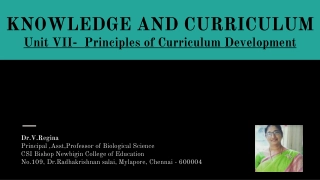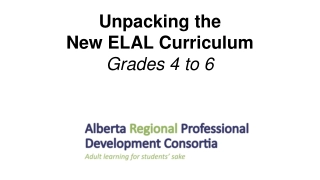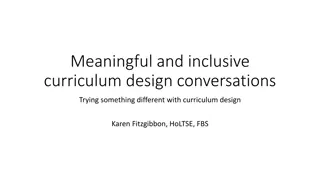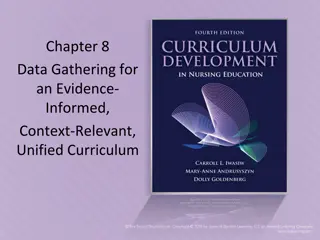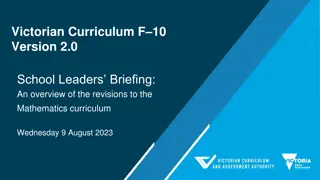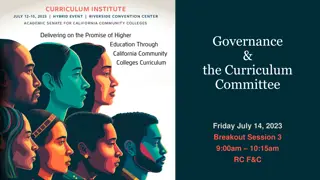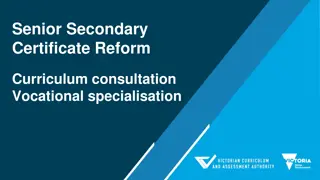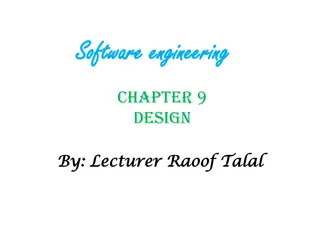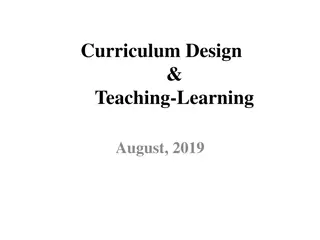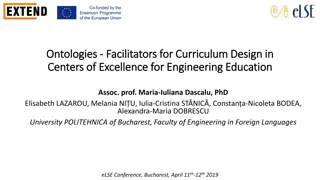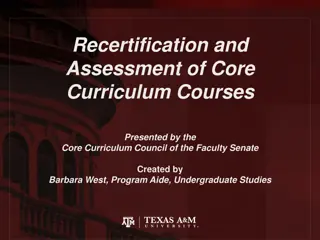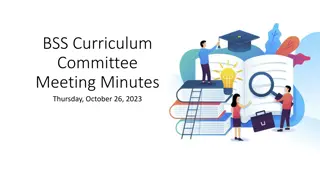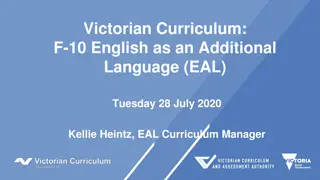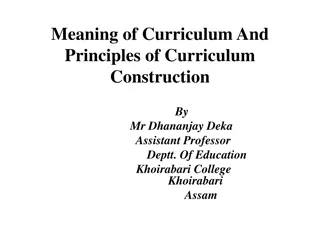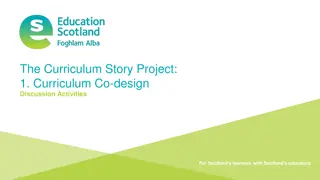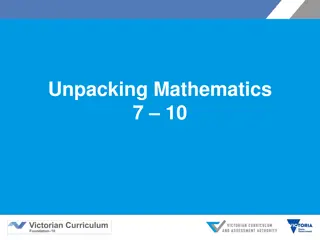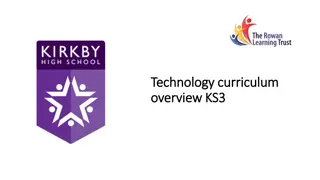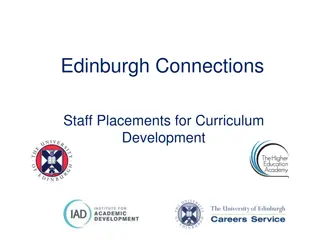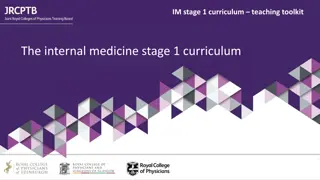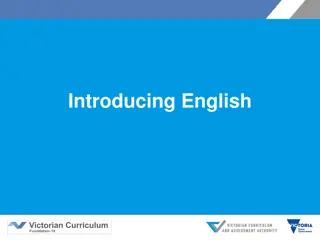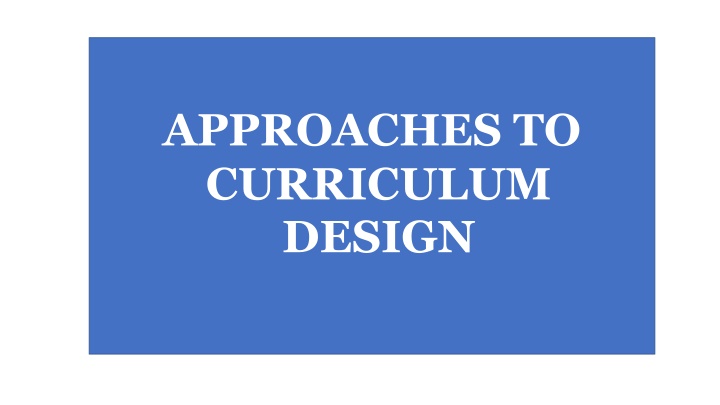
Effective Curriculum Design for Successful Learning
Discover the essential aspects of curriculum design, including its meaning, approaches, and major elements. Learn how to arrange curriculum components effectively to facilitate teaching and learning processes, ensuring student understanding and success.
Uploaded on | 0 Views
Download Presentation

Please find below an Image/Link to download the presentation.
The content on the website is provided AS IS for your information and personal use only. It may not be sold, licensed, or shared on other websites without obtaining consent from the author. If you encounter any issues during the download, it is possible that the publisher has removed the file from their server.
You are allowed to download the files provided on this website for personal or commercial use, subject to the condition that they are used lawfully. All files are the property of their respective owners.
The content on the website is provided AS IS for your information and personal use only. It may not be sold, licensed, or shared on other websites without obtaining consent from the author.
E N D
Presentation Transcript
APPROACHES TO CURRICULUM DESIGN
Learning objectives: By the end of this module, each student teacher should be able to: 1. Explore the meaning of curriculum design 2. Describe the sources for curriculum design 3. Identify the approaches to curriculum design
MEANING OF CURRICULUM DESIGN Curriculum design is largely concerned with issues such as what to include in the curriculum and how to present it in such a way that the curriculum can be implemented with understanding and success (Barlow et al, 1984). It therefore refers to the way in which the component parts or elements of the curriculum have been arranged in order to facilitate learning (Shiundu & Omulando, 1992).
Therefore, curriculum design refers to arrangement of the elements of a curriculum into a substantive entity aimed to facilitate teaching and learning process (instruction) at school. Some curricularists use design as a verb for the actual process of creating a curriculum or instructional plan with particular organization of elements/components. The design that someone actually selects is influenced by his/her curricular approach, philosophical orientation, theoretical and practical issues.
Most curriculum writers do not have a single or pure design for curriculum, they tend to be influenced by different designs. Design is a complex phenomenon requiring of educators careful attention so that the curriculum conceived will have merit and will succeed in getting students to learn those concepts, attitudes, and skills considered worthwhile, meaningful and essential.
WHAT IS CURRICULUM DESIGN? Arrangement of the elements of a curriculum into a substantive entity. Aimed to facilitate teaching and learning process (instruction). Comes after planning stage.
MAJOR CURRICULUM ELEMENTS Aims, Goals, and Objectives Subject Matter/Content Learning Experiences/Methods Evaluation Approaches
AIMS AND OBJECTIVES Reasons for undertaking the teaching and learning journey (Likely results of a program). Origin stakeholders or learners.
SUBJECT MATTER/CONTENT Values, beliefs and practices to be developed in students. By reflecting on the objectives and learners at hand, is the content: -Relevant and appropriate? (age, context, demand) -Up-to-date? (research based)
LEARNING EXPERIENCES These are the means/ways by which students will engage with the syllabus. Consider carefully: Individual vs Group study/tasks One way vs Didactic methods
EVALUATION Feedback mechanism Three forms Self, Peer and Tutor All assessment mechanisms should be integrated together in the curriculum.
The curriculum design process results in a curriculum document that contains the following aspects: A statement of purpose(s). An instructional guide that displays behavioral objectives and content organization in harmony with school organization. It explains how people might acquire knowledge and learn. An evaluation scheme. A set of guidelines or rules governing the use of the curriculum.
SOURCES FOR CURRICULUM DESIGN Society Learner Sciences Knowledge (Discipline and Eternal/Divine Sources) Philosophy
To determine the influences of curriculum design, attention must be given to how the above sources will influence education. How the curriculum planner responds to the question of the sources of ideas for education will affect his/her views of curriculum design.
SOCIETY AS A SOURCE Society is a most powerful influence on the design of curriculum. John Dewey realized that educators needed to be in touch with needs of society. Curriculum designers believe that school is an agent of society, thus the school should draw its ideas for the curriculum from the analysis of the social situation. Curriculum design can only be completely understood if it is contextualized socially, economically, and politically.
LEARNER AS A SOURCE The learner is considered as the primary source of curriculum design. Curriculum should be derived from what we know about the learner how he/she learns, forms attitudes, generates interests, and develops values. We are looking specifically at the students intelligence or mind as a source influencing curriculum design.
SCIENCE AS A SOURCE Curriculum workers who rely on science as a source usually maintain that the scientific method provides meaning for the curriculum design. Designs that stress learning how to learn or thinking curricula emphasize scientific procedures. This view of curriculum design coincides with the scientific and rational world.
KNOWLEDGE AS A SOURCE Those who place knowledge as a key source, realize that it is organized in specialized ways. Disciplined Knowledge: Has a particular method or methods by which scholars extend its boundaries. Divine Knowledge: Draw on the past for guidance as to what is appropriate content. It is related to eternal truth revealed through such sources as the Bible or other religious documents.
PHILOSOPHY (THE MAJOR INFLUENCE) Philosophy influence frameworks for decisions, choices and alternatives. Without philosophy, educators are directionless in the WHATS, HOWS and FOR WHOMS WHAT subjects are of value (Why?) HOW students will learn FOR WHOM Accessibility and Inclusiveness of curriculum
BASIC PHILOSOPHICAL QUESTIONS What is knowledge and understanding? What is worth knowing? What does it mean to learn? How do you know that learning has taken place? What should be the role of a teacher? What should be the role of the student? What is the ultimate purpose of education? What are your core educational values?
PRINCIPLES GUIDING CURRICULUM DESIGNS These are basic ideas to be considered that helps to select and shape/organize ideologies of given philosophical ideas in the curriculum: 1) Goal/Outcome oriented 2) Adaptability: Encourage students ability to respond to technical changes in knowledge and sciences 3) Consistently promote ethos/culture of innovation, creativity and professionalism 4) Accessibility to larger population (Inclusive) 5) Include authentic (reality) and applicable experience 6) Integration
1. OUTCOME ORIENTED Any curriculum must be guided by the question: What are specific capabilities students must have at its conclusion? NOTE: Goals further: Serve as techniques foundation for the entire curriculum. Helps in evaluating the program.
2. ADAPTABILITY AND CONTINUITY Most of the subjects taught in schools are vibrant and fast changing discipline. Equally importantly, the curriculum must teach students to respond to change as well eg socioeconomic and technological changes. Thus, subjects specialists must update their curricula on a regular basis.
3. PROMOTING SCIENTIFIC ATTITUDE The curriculum as a whole should maintain a consistent ethos/culture that promotes innovation, creativity and professionalism. Throughout the entire curriculum, students should be encouraged to use their initiative and imagination to go beyond the minimal requirements ie responsibility under minimum supervision and a culture of inquiry mind.
4. SOCIAL INCLUSSIVENESS Ensure that the curriculum is accessible to a wide range of students. Ensure that a curriculum is not selective ie eliminate bias in terms of gender, color, age, cognitive abilities etc. HOW? Relevance Organization sequentially, simple complex, helical Implementation Multiple intelligence
5. AUTHENTIC EXPERIENCE Any curriculum must provide relevant experiences ie it must provide students with a capstone experience that gives them a chance to apply their knowledge and skills to solve a challenging problem. Known abstract learning helps students to practically become problem solvers.
6. INTEGRATION Every subject taught in a school is a discipline in its own right. Being a disciplines, they are characterized by a combination of theory, practice, knowledge and skills. THUS link all types of knowledge and experiences contained within the curriculum plan. Enables the individual to comprehend knowledge as unified.
APPROACHES TO CURRICULUM DESIGN Decision of which design is to be followed depends on the assumptions and believes the designers have in relation to WHAT, HOW and FOR WHOM the curriculum is designed for. It is important to note that there is no single theory or principle for the approaches. However, we have a consensus on some approaches basing on the historical experience.
The common approaches to curriculum design includes: 1. Learner-centered approach 2. Subject-centered approach 3. Problem centered approach 4. Traditional/Fact-based approach 5. Values based approach 6. Broad field approach
LEARNER-CENTERED APPROACH This approach to curriculum design is based on the underlying philosophy that the learner is the center of educational process. It means that the curriculum is constructed based on the needs, interests, purposes and abilities of the learner s knowledge, skills, learning and potentials. In this approach the students influence the content, activities, materials and pace of learning.
CHARACTERISTICS: A new respect for the learner (individual) is fundamental. A new freedom of actions is provided. The whole activities is divided into units of works. The recognitions of the needs for using and exploring many media for self discovering and self direction is embraced. The system of education focus on what is best for students.
SUBJECT-CENTERED APPROACH This is the most popular and widely used curriculum approach because knowledge and content are well accepted as integral parts of the curriculum. This approach considers the following: -The primary focus is on the subject matter. -The subject matter seems as means of identifying problem in living. -The continuing pursuit of learning outside the schools is not emphasized, ie learning should take place only inside the school.
PROBLEM-CENTERED APPROACH This approach is based on a curriculum design which assumes that in the process of living, the main consideration is the children experience problems. Teaches students how to look at a problem and formulate a solution. Thus, problem solving is emphasized. It enables the learners to be able to achieve complete or total development as individual.
FEATURES OF PROBLEM CENTERED APPROACH Learners are capable of directing and guiding themselves in solving problems, thus they become independent learners. The curriculum leads the learners in the recognitions of concerns and problems and in seeking solutions. The approach helps students develop skills that are transferable to the real world. The learners are prepared to assume their civic responsibility through participatory and different activities.
TRADITIONAL/FACT-BASED APPROACH TO CURRICULUM DESIGN Curriculum design traditionally has focused on the transmission of discrete pieces of information frequently rote facts and formulas from teacher to student. Because the information is considered important in its own right, traditional curriculum designers often pay little attention to whether or not students use the information in any real life context. It requires students to cover topics, memorize facts, and restate them for evaluation purposes.
In this kind of curriculum, segregation of knowledge is used to impose order on information. In reality, most learning situations demand an integration of various kinds of knowledge, and information is considered valuable insofar as it fills an experienced desire or need for information. Because traditional curriculum design does not reflect these realities, it often does not provide students with opportunities to develop the kinds of critical thinking skills and problem-solving abilities that are central to thinking and learning.
Curriculum is organized according to how essential knowledge has been developed. Furthermore, traditional curriculum design does not include opportunities to build the kinds of personal and collaborative skills that support learning (Tinzmann, et al, 1990 & Jones, et al, 1987).
CHARACTERISTICS: Traditional teachers believe that a child comes to them as an empty vessel and it is their job to fill them with knowledge. Traditional teachers usually lecture and then give worksheets. They follow the textbooks completely. In addition to its overemphasis on verbal answers, reliance on rote memorization (mindless memorization with no effort at understanding the meaning), Emphasizes direct instruction and lectures, students learn through listening and observation.
The teacher is considered a respected role model in the community, students should obey the teacher. A passing grade may or may not signify mastery of content. Some students will fail due to poor performance based on a lack of understanding. Emphasis on memorization of basic facts and step-by- step manual arithmetic algorithms, one correct answer is sought, using one standard method with practice and solved. Students focus on memorizing what they are told.
Science class is an opportunity to transmit concrete knowledge from the teacher or textbook to the students. Designers pay little attention to whether or not students use the information in any real life context.
Advantages: Test scores can be easily quantified so students, tutors and teachers can point to quantifiable progress, and that is certainly motivating. Program administrators can use the results of traditional tests to justify their programs achievements. The traditional approach is efficient in a field in which resources for staff development are scarce. Teachers can create their own materials and methods using a traditionalist approach.
Volunteer tutors and adult basic education teachers without much training or time can easily teach from an existing curriculum. The traditional approach is also accessible. The produced traditional curricula and materials in computers are widely available to learners who are interested in studying on their own. They don t have to wait for a class to start or fit it into their schedules.
Disadvantages: The teacher has a more valued form of knowledge, and more control, than the student. The student s role is passive, and serves as an example of "banking education," in which the expert teachers deposit knowledge into the student who lacks knowledge. In its most extreme, the traditional model omits the importance of learner experience, requiring a learner to accept, rather than challenge, the information being transmitted. Discrete skills can be taught under the assumption that they will automatically transfer to any variety of situations inside and outside.
VALUES EDUCATION APPROACH TO CURRICULUM DESIGN Values, as we understand it, can be defined as the beliefs held by individuals to which they attach special priority or worth, and by which they tend to order their lives. However, a value is also more than a belief; it constitutes a worthiness of a norm or a principle embedded in a person, a group, a religion or a belief system.
Thus, since a school is a representative of a larger social system where individuals differ in terms of beliefs and attitudes, it is required to know the ways to accommodate them together so that to enhance the social progress. Thus, with the focus in the school curriculum on knowledge, skills and values, teachers will have to facilitate different value and belief systems into all learning areas across the curriculum.
Values education approach to curriculum design is designed to assist schools and teachers to integrate values within key learning areas of the school curriculum. This approach promotes teacher learning about values education and supports teachers as they impart values within all areas of the curriculum.
It is designed to support schools in integrating values in curricular and extracurricular contexts to develop student responsibility, social skills, resilience and wellbeing. Values approach supports values learning through activities and projects outside the formal curriculum It acknowledge that the recognition, worth and integrity of all involved in the life and work of the school, are central to the creation of a value-based learning community that fosters positive relationships and quality in education (Alive, 2007)
Some of the values that need to be considered in the syllabus are: To teach democratic citizenship (learn how to get along with each other and to participate cooperatively in making the nation work). To emphasize on religion and moral training in schools, that is curriculum should reflect to basic values that society collectively held even though society included many different groups such as religious and ethnic groups
To address and then add to already existing curricula all social problems like HIV AIDS, parental care, drug- abuse, crime, violence, abortion, suicide, sex abuse and other numerous social problems. These values could help peoples to reduce emotional, behavior and academic problems. To teach about civic responsibility so that people could learn how to be responsible to the government and public in general.
Teach some values common to virtually all cultures values such as kindness, honesty, loyalty, friendship, courage, trustworthiness, fairness and service to others. Note: Some of these values could be imparted through formal, informal or non-formal curriculum.


